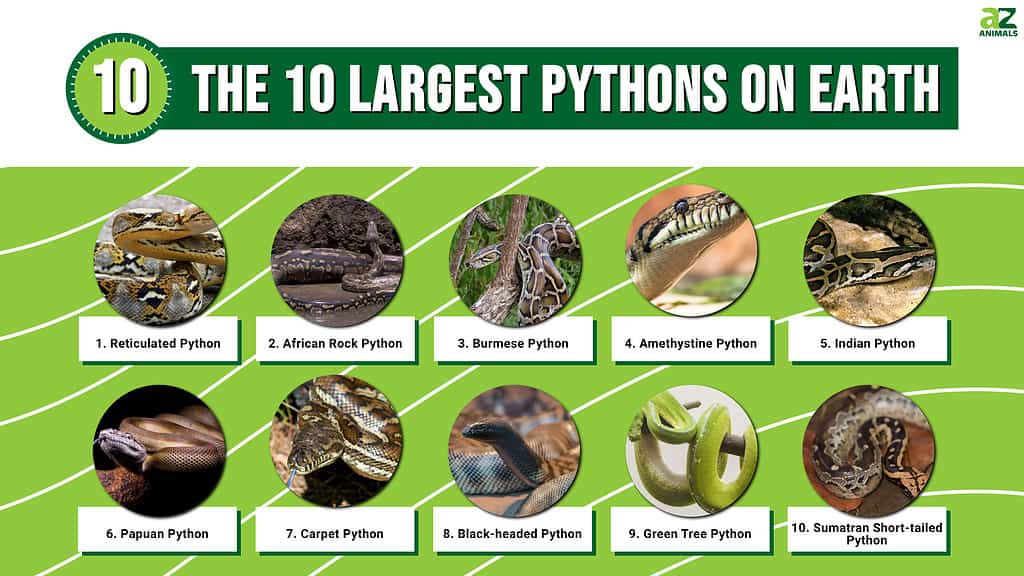
Pythons are some of the biggest snakes on Earth. Here, we’ll learn about the ten largest pythons in the world, and where they live. All pythons are non-venomous snakes that rely on constriction, rather than venom, to hunt. They live in Africa, Australia, and Asia—there’s even a population of invasive Burmese pythons living in Florida’s Everglade National Park. Pythons may look similar to boa constrictors and anacondas, but they’re actually a completely different type of snake. All in all, there are 42 known species of python encompassing ten genres and four continents.
Let’s learn more about the ten largest pythons in the world.
10. Sumatran Short-tailed Python (Python curtis)
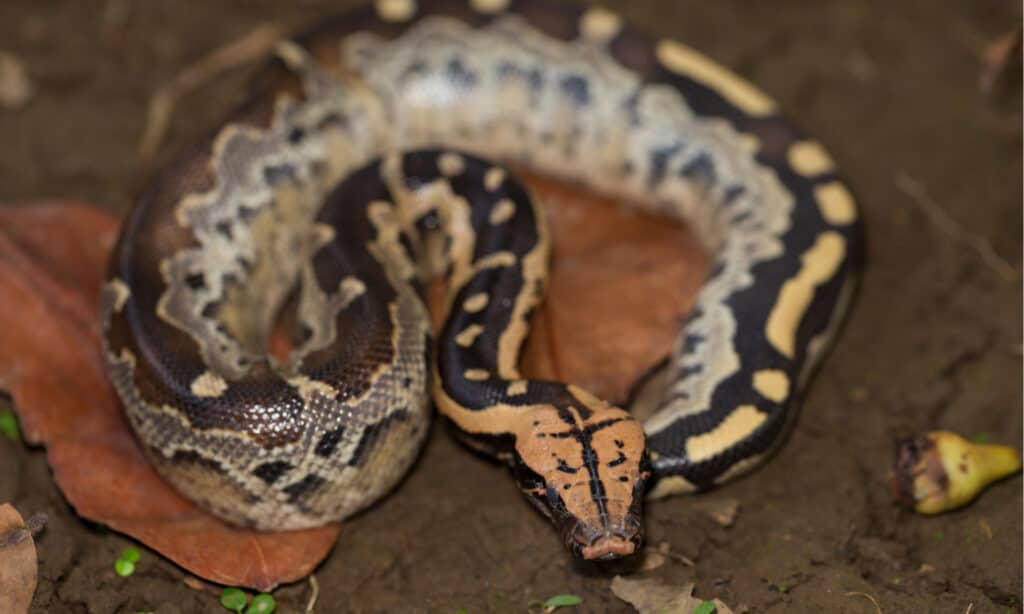
These snakes live in Sumatra and the surrounding islands. They prefer semi-aquatic environments like rivers, swamps, and marshes.
©dwi putra stock/Shutterstock.com
The Sumatran short-tailed python is small for a python but very large for a snake. They grow to lengths of around six feet, with heavy bodies designed for constriction. Their tails are extremely thin compared to the rest of their body, hence their name. Sumatran short-tailed pythons have brown coloring with light brown and tan markings.
9. Green Tree Python (Morelia viridis)
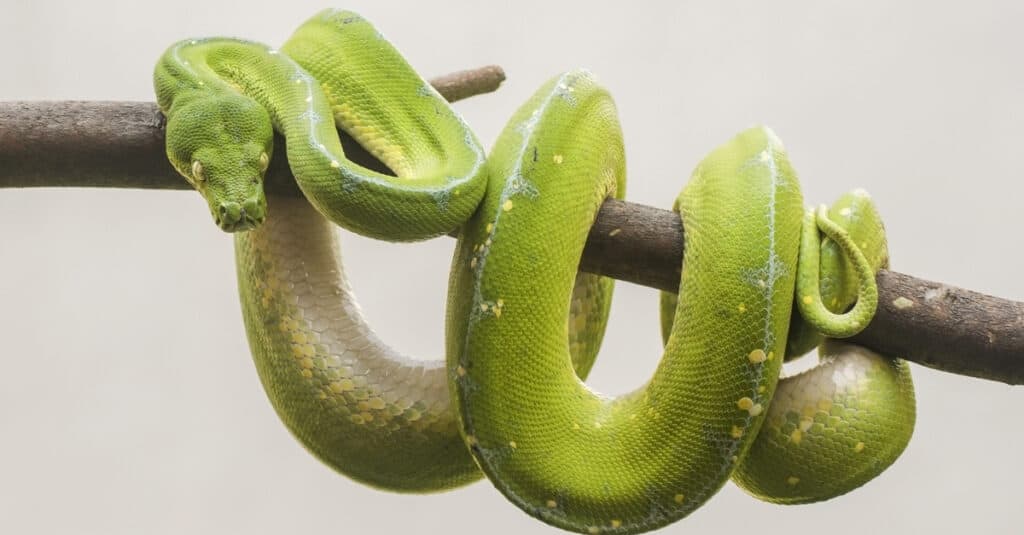
These snakes occur in Papua New Guinea and Australia’s Cape York Peninsula. They spend most of their lives in the trees.
©Franny Constantina/Shutterstock.com
Green tree pythons are among the largest snakes in the world, even if they’re dwarfed by number one on our list. They grow to around 6.5 feet in length and have thinner bodies than most species of python. They’re bright green with tiny white spots, and make popular pets for snake enthusiasts.
8. Black-headed Python (Aspidites melanocephalus)
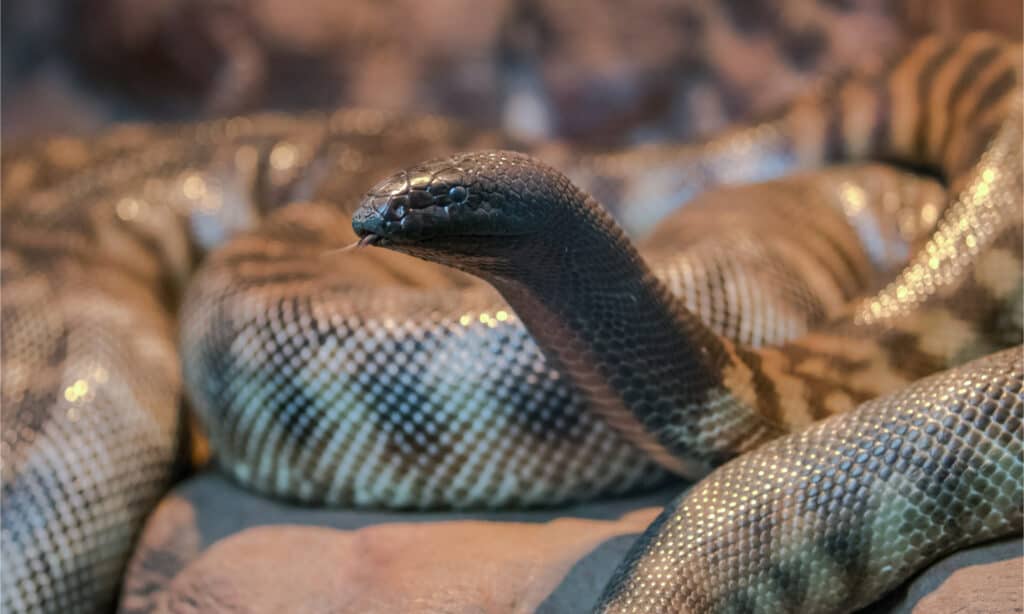
These pythons live in a variety of habitats along the coast of northern Australia. They live primarily on the ground, where they hunt for reptiles.
©Ken Griffiths/Shutterstock.com
Black-headed pythons typically grow to around 6.5 feet, but can reach lengths of ten feet or more in ideal conditions. They’re found in wooded areas as well as semi-desert settings and rocky hillsides. Black-headed pythons are mostly light brown with darker stripes, but, as their name suggests, they have distinct all-black heads. Their unique coloring makes them a popular pet species, despite their potential to grow very large.
7. Carpet Python (Morelia spilota)

These snakes live in Papua New Guinea, Indonesia, Australia, and the
Solomon Islands
.
©Michelle Marks/Shutterstock.com
The carpet python is one of the largest pythons in the world, reaching lengths of over 13 feet. They can weigh more than 30 pounds, which makes them one of the heavier snakes in the world. Carpet pythons have distinct markings created by dark and light scales among the plain brown scales that typify their bodies. They prefer forested areas, and eat mainly small to medium-sized mammals, birds, and other reptiles.
6. Papuan Python (Apodora papuana)
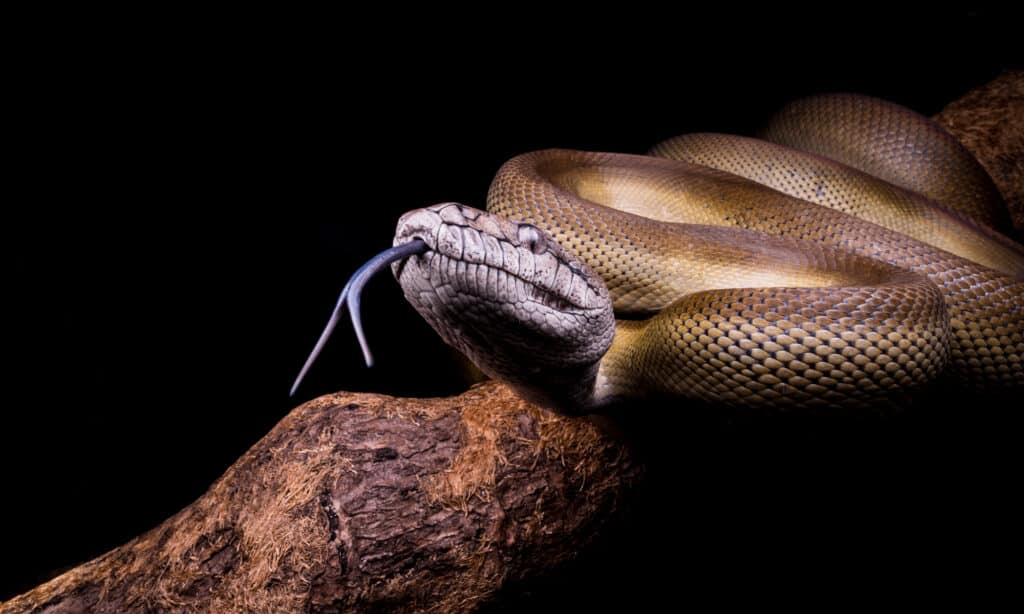
These pythons live only in New Guinea, where they are also known as Irian pythons, or Papuan olive pythons.
©Sibons photography/Shutterstock.com
The Papuan python grows to a maximum length of about 13 feet, though there are unsubstantiated reports of females growing a little bigger. They’re thin-bodied, but still rank as some of the largest pythons in the world. Papuan pythons range in color from nearly black to yellow or olive green.
5. Indian Python (Python molurus)
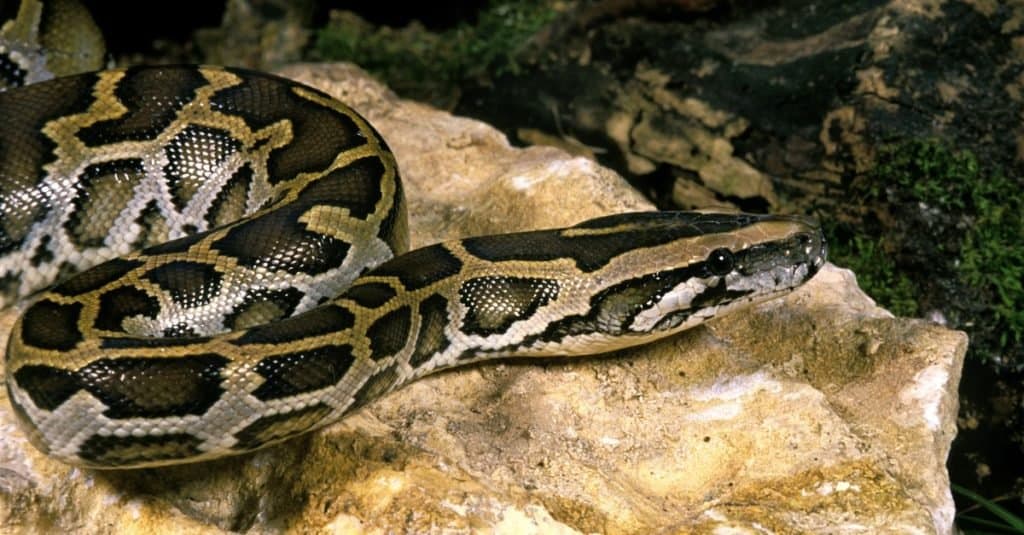
As their name suggests, Indian pythons live in the Indian subcontinent and throughout Southeast Asia.
©slowmotiongli/Shutterstock.com
One of the largest pythons in the world, the Indian python can reach lengths of 10 feet and in some extreme cases even larger. The world record for the longest Indian python was a 15-foot long specimen that weighed 110 pounds!
They’re also known as black-tailed pythons, Indian rock pythons, or Asian rock pythons. Frequently confused with Burmese pythons, these snakes have distinct dark brown splotches overlaid on a light brown body. They live everywhere from rocky hillsides to swamps; as long as they’re close to water, Indian pythons can find a way to thrive.
4. Amethystine Python (Simalia amethistina)
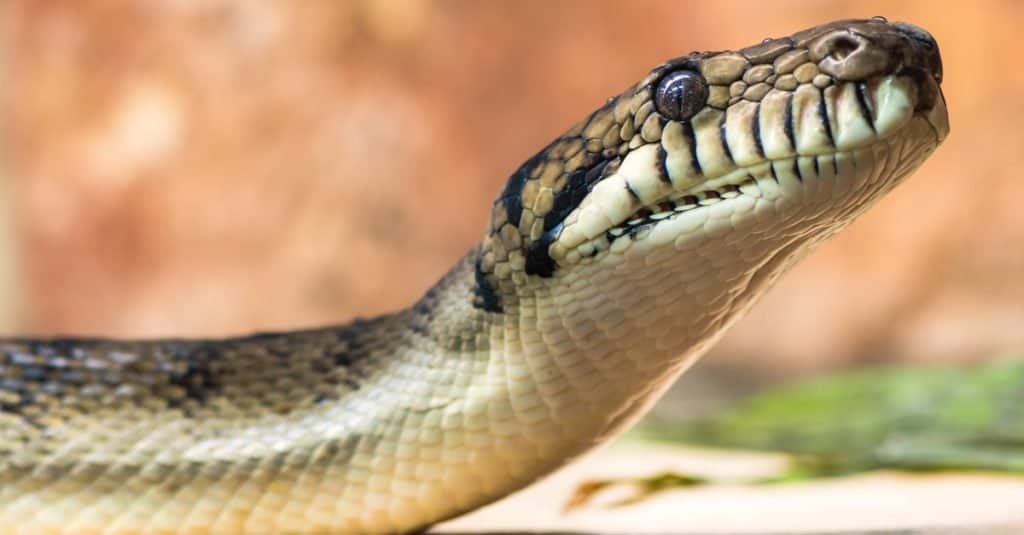
Also known as the Australian scrub python, these are the
largest snakes in Australia
.
©IanRedding/Shutterstock.com
Amethystine pythons are one of the largest pythons in the world. Though most grow to only about 13 feet, the biggest amethystine pythons can exceed 20 feet long, and weigh more than 20 pounds. In 2015 an extremely large Amethystine python was captured that had an estimated weight of 110 pounds, which shows just how big these snakes can grow. They live in the tropical rainforests of New Guinea and northern Australia. Amethystine pythons are heavy-bodied, with light brown to yellow coloring. They feed primarily on small mammals and birds.
3. Burmese Python (Python bivittatus)
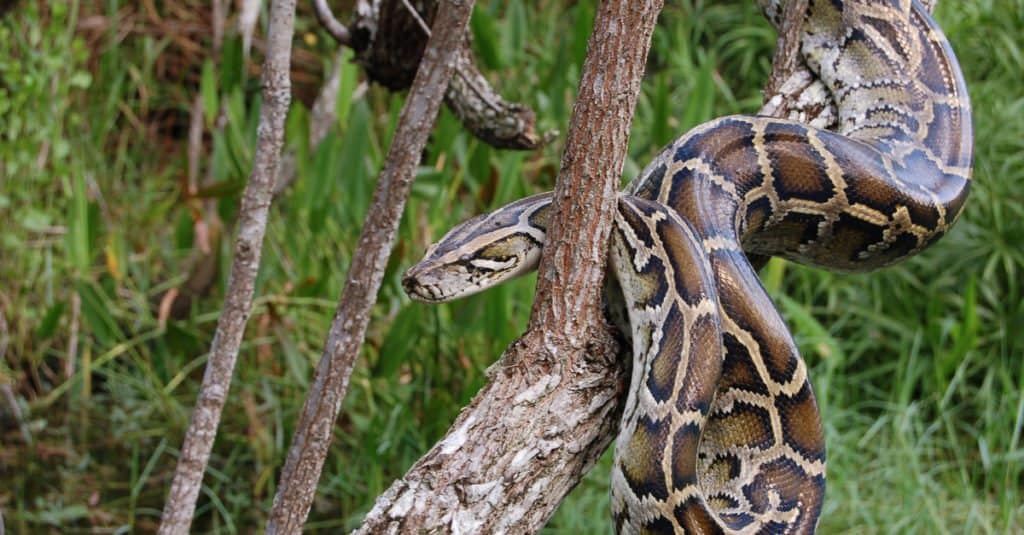
These snakes are native to Southeast Asia, where they’re listed as Vulnerable.
©Heiko Kiera/Shutterstock.com
One of the largest pythons in the world, the Burmese python regularly grows to lengths of more than 11 feet. They’re heavy-bodied snakes, with some weighing over 100 pounds. In fact, a large Burmese python named “Baby” was weighed in at 403 pounds and measured just shy of 19 feet long.
Burmese pythons are endemic to Southeast Asia, but they’re also considered an invasive species in the Florida Everglades. They spend their lives on the ground, in the trees, and in the water, where they hunt for small to medium sized mammals, birds, and amphibians.
2. African Rock Python (Python sebae)
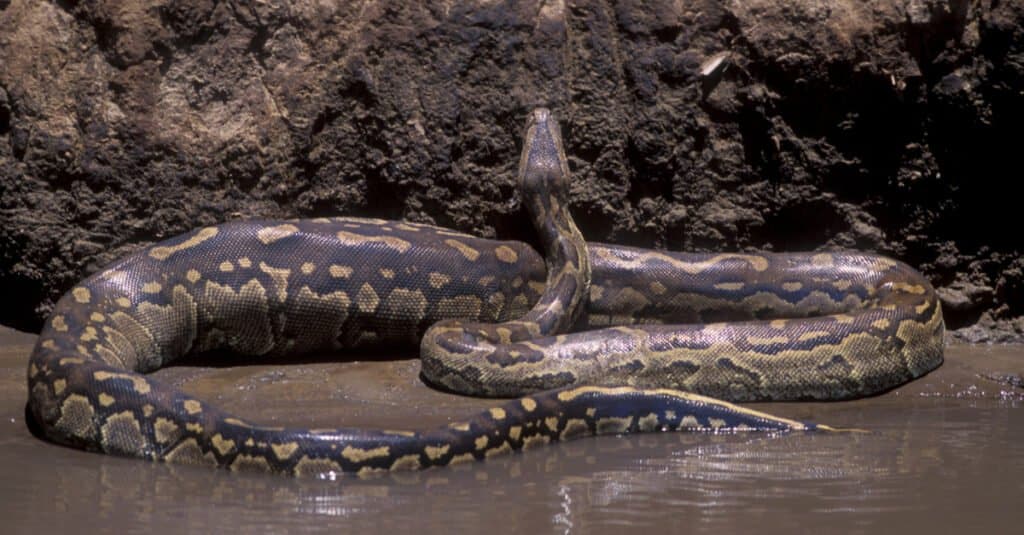
These snakes live throughout sub-Saharan Africa. They’re currently listed as
Near Threatened
due to poaching and habitat loss.
©zaferkizilkaya/Shutterstock.com
Number two on our list of the largest pythons in the world is the African rock python. Most adults grow to about 12 feet long, though lengths of over 16 feet are not uncommon. Some African rock pythons have even been measured at nearly 20 feet. African rock pythons can weigh over 100 pounds, making them one of the heaviest pythons in the world. In fact, rock pythons hold the record for the largest meal ever recorded by a snake! A rock python was recorded eating a hyena estimated at 150 pounds. They feed on medium-sized mammals and reptiles, even Nile crocodiles.
1. Reticulated Python (Malayopython reticulatus)

These famous snakes are native to Southeast Asia and Indonesia.
©Opayaza12/Shutterstock.com
Reticulated pythons are the largest python in the world. They’re also generally considered the longest snakes in the world. Reticulated pythons can grow to over 20 feet long, and weigh over 150 pounds. They have distinct markings made up of black, white, yellow, and caramel-colored scales, and long, narrow heads. Like all pythons, reticulated pythons are non-venomous, and use constriction to crush and suffocate their prey. The largest python ever officially recorded is named Medusa. The snake lives in Kansas City, Missouri and has been measured at 25.2 feet, and weighs 350 pounds. There have been various reports of larger pythons, such as a 26.25-foot long python that reportedly weighed 550 pounds captured in Malaysia in 2016. However, reports of these “monster” snakes that are far larger than ones properly measured in captivity are hard to verify.
Pythons vs Boa Constrictors
Commonly mistaken for each other, pythons and boa constrictors are actually quite different snakes. One way to tell these snakes apart is where you’re located. Boas are mainly found in the western hemisphere of Central and South America, while pythons are Old World snakes found in Africa, Asia, and Australia.
Another way to distinguish these snakes is their skull anatomy. Boas have fewer bones in their skulls and fewer teeth than pythons. Pythons also have upper jaw bones with teeth. Boas also tend to be smaller than pythons at around 4-12 ft.
Considering these facts, it can be quite easy to tell these species apart when comparing boas and pythons.
Facts About Pythons
Below are 10 Incredible Python Facts:
- Pythons come in a vast array of colors.
- Pet Python Fact: Ball Pythons Are the Most Popular Pet Snake
- Reticulated Pythons Are the Largest Scientifically Measured Snakes on Records
- Pythons Can Live for 40 Years or More
- Two Irula Tribesmen from India Caught 27 Pythons in Florida in Four Weeks
- A Concerning Python Fact: They’re an Invasive Species in the U.S.
- Pythons Swallow Their Prey Whole
- Baby Pythons Survive on Their Own When They Hatch
- Reticulated Pythons Can Eat Fully Grown Humans
- Pythons Are Constrictor Snakes with No Venom
Summary of the 10 Largest Pythons on Earth
| Rank | Species |
|---|---|
| 1 | Reticulated Python |
| 2 | African Rock Python |
| 3 | Burmese Python |
| 4 | Amethystine Python |
| 5 | Indian Python |
| 6 | Papuan Python |
| 7 | Carpet Python |
| 8 | Black-headed Python |
| 9 | Green Tree Python |
| 10 | Sumatran Short-tailed Python |
Does a Hybrid Python Exist?

Burmese
pythons have been found to have DNA of Indian rock pythons in the Florida Everglades, producing a hybrid snake that’s better suited to thrive than its non-hybrid cousins.
©dwi putra stock/Shutterstock.com
One U.S. state where it’s been proven that hybrid snakes exist is the state of Florida. Florida has been dealing with certain invasive snake species like Burmese pythons for decades. Burmese pythons pose a serious threat to wildlife in the Florida Everglades, as they are apex predators that have no natural predators there. They cover an area of 1,000 square miles in the Everglades with an estimated population of 100,000 snakes.
Certain captured pythons that were studied were found to be hybrids–they contained DNA of both Burmese pythons and Indian rock pythons, a smaller python species that does not have an established population in that region. The study concluded that about 3% of the 400 wild Burmese pythons were hybrids. It’s thought that these snakes were somehow crossed before coming to live in the swamps there. Researchers also believe this hybridization gives the invasive pythons an edge over their non-hybridized cousins. They’re better suited to thrive in a wide range of habitats than non-hybridized Burmese pythons, making them even more of a threat to Florida’s biodiversity.
Could these hybrid pythons become “super snakes” in size? Only time will tell.
The photo featured at the top of this post is ©
Discover the "Monster" Snake 5X Bigger than an Anaconda
Every day A-Z Animals sends out some of the most incredible facts in the world from our free newsletter. Want to discover the 10 most beautiful snakes in the world, a "snake island" where you're never more than 3 feet from danger, or a "monster" snake 5X larger than an anaconda? Then sign up right now and you'll start receiving our daily newsletter absolutely free.
Thank you for reading! Have some feedback for us? Contact the AZ Animals editorial team.






